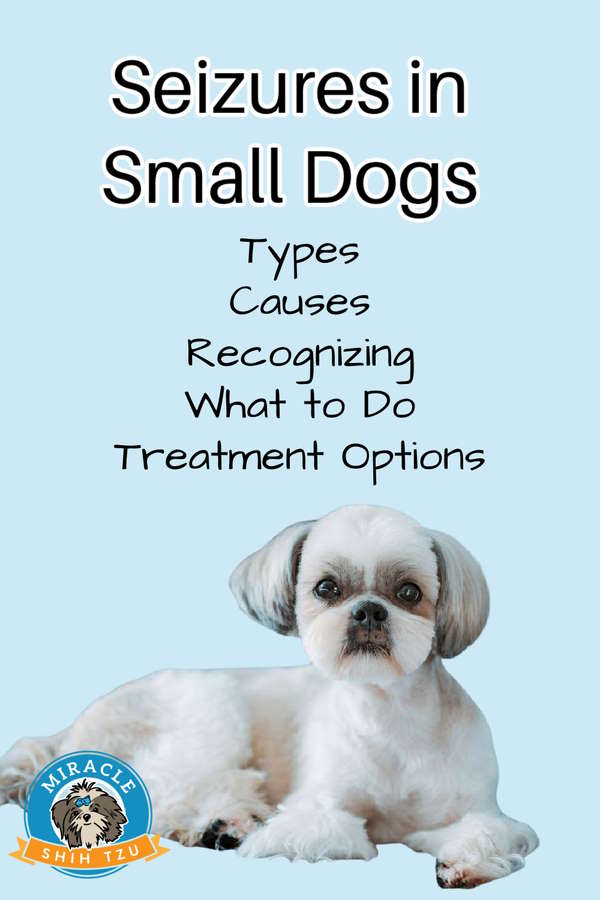Seizures in Small Dogs - What You Need to Know!
Seizures in Small Dogs
Dogs enrich our lives with their caring nature, unconditional love, comfort during troubled times, and unwavering companionship. These empathetic creatures give us hope for the future and a feeling of purpose in life. Dogs simply are the best!
And witnessing your canine best friend go through a seizure can be a scary and stressful experience. We are fully aware of how frightening it is to watch. But it's important to keep calm and avoid panicking, as they often aren't life-threatening.
In this article, we're going to talk about what dog seizures are, why they occur, and what to do if your dog experiences one.

Let's jump right in! Seizures in Small Dogs
Seizures are a common occurrence in dogs. They refer to a neurological condition in which changes in canine behavior, consciousness, and body movements happen due to temporary disruption of normal brain function.
There are different types of seizures in dogs, each with a unique set of symptoms and patterns. We have listed out a few for you;
- Generalized Tonic-Clonic Seizures: It is one of the prevalent types of seizure during which a dog may experience limb stiffening; a tonic phase, followed by a clonic phase; rhythmic jerking of limbs.
- Absence Seizures: Absence seizures fall more in the behavioral spectrum. In the case of petit mal seizures, your doggo will be unresponsive (even if you offer a treat), staring into space (not in an existential crisis way), or will have brief episodes of chewing or lip-smacking. If all the muscles of your dog move spastically or erratically with the loss of consciousness, that indicates a full-blown or grand mal seizure. Your dog's head will be drawn backward, on her side, and her legs paddling. It can last between a few seconds to minutes.
- Focal Seizures: Also called complex partial seizures are psychomotor seizures characterized by localized twitching or shaking in your dog. Focal seizure activity may also include the display of aggression, confusion, or fear.
- Cluster Seizures: If your dog experiences more than one or two seizures within the time frame of 24 hours, the chances are your little fella is experiencing cluster seizures. It can be dangerous and demands the veterinarian's consultation immediately.
- Status Epilepticus: In status epilepticus, a seizure lasts more than five minutes, or a dog experiences repeated episodes without regaining consciousness in between the seizures. It is a medical emergency and can cause serious brain damage.
It's important to note that the duration and intensity of a seizure can vary from dog to dog. Some might experience mild symptoms, while others may suffer from severe seizures. Observe closely and consult a vet if necessary.
Why Do Small Dogs Have Seizures?
Let's look at the different causes that may cause seizures in dogs:
Genetics
Idiopathic epilepsy, one of the most common types of seizure disorder, can affect a dog of any breed or age. There's no identifiable etiology for this; however, it is largely believed to have a genetic basis.
Neurological disorders
Structural brain abnormalities like brain tumors, brain infections, or head trauma can also cause seizures/epilepsy in dogs.
Congenital defects, such as cerebellar hypoplasia (an underdeveloped brain) and hydrocephalus (fluid in the brain), can also lead to seizures in dogs.
Toxins and poisons
Even certain household food items can be potential toxins for your dog. For instance, exposure to dark chocolate, ethanol, bromine, mushrooms, xylitol, or more toxic ones (poisoning) like lead and organophosphate insecticides can instigate seizures.
Infections
Infectious diseases, including distemper or encephalitis, can contribute to seizure occurrence in canines.
Metabolic imbalances
Metabolic conditions/imbalances such as kidney & liver disease, hypothyroidism, and hypoglycemia can also cause seizures in dogs.What happens during a typical seizure? (Signs and symptoms in small dogs)
Seizures sometimes get confused with shivering or tremors due to their similarities. The prominent difference is the awareness of surroundings, which, in the case of seizure, is absent.
How to Recognize Seizures in Small Dogs
So, what actually happens during a seizure, and how do you recognize it? The following signs and symptoms indicate a seizure:
- Your dog may become unsteady, lose balance, and has trouble walking
- Chomping or chewing movements despite having nothing in their mouth
- Your dog may have muscle contractions, twitching, jerking, or shaking
- Excessive drooling or foamy saliva (it doesn't mean rabies)
- Repetition of odd behaviors
- Urination or defecation due to loss of control over the bladder or bowel
- Display of restlessness, anxiety, or aggressivenes
- Paddling( kicking their legs) or running movements
- Stiffening of muscle, fall to the side, or collapse
- May lose consciousnessWhat to do if your dog is seizing, and how to help?

What Should You Do if Your Dog is Seizing?
Seizures in dogs can occur out of the blue, without any warning, turning your flight and fight mode on. Here's what you should do if your dog is seizing:
- Keep yourself calm: Panicking in such a situation is an expected response. However, don't let it take over you, and try to calm yourself down. Remember, it's your ability to focus that will help your furry chum.
- Time your dog’s seizures: You need to carefully monitor your dog's seizures. Calculating the duration of the seizure can be considerably helpful in making the correct diagnosis. Or, even better, record it on your phone and show it to the vet.
- Sit Near your Dog: Avoid touching your dog. She might unintentionally bite you, or you might hurt her in some way. Rather, sit near so that your presence is acknowledged.
- Carefully move your dog to a safer location: During a seizure, dogs can unknowingly hurt themselves. Pull them away from stairs (from the hind leg), move any dangerous objects in the vicinity, and place cushions around them (especially over the sharp edges of furniture).
Once the seizure is over, keep your dog in a safe location. - Use Comfortable voice mode: Just like humans, dogs also have the ability to sense the tone of your voice. So, use a comfortable voice mode, and say reassuring words or sentences that will make them feel safe, comforted, and loved.
- Lower the body temperature of your dog: A seizure lasting more than 2-3 minutes can pose the risk of hyperthermia or overheating/rise in temperature in your dog. You can use cold water or use a wet towel to bring the heat down. Although, seeking the vet's help will be more reasonable.
- Let your dog sleep: After a seizure, your dog's activity will be disoriented and they will feel drained. Therefore, it's best you craft a comforting environment and let them sleep in peace for a while.
- Let your dog eat and drink: Shower your dog with lovey-dovey remarks, cuddle them, and also lighten them up with a treat. Dogs tend to get really hungry and thirsty after a seizure; let them eat or drink on their own.
Your best friend will get back to the mischievous, wholesome mode in no time!Are Dog Seizures Treatable? (If yes, how?) There's no such thing as a permanent cure for seizure, unfortunately.
Depending on the underlying cause, your vet may proceed with a dietary change, therapy, or certain medications.
Anti-convulsants like phenobarbital and potassium bromide are commonly used medications to treat or control seizures. It is said that "once an anti-convulsant is started, it must be given for a lifetime."
That statement has to do with the medication's side effects. If the dose is missed or discontinued, the risk of severe seizure in the future escalates. Besides, the treatment focus on minimizing the seizure to improve the quality of your dog's life.Is a seizure painful or dangerous for my dog?
Despite the frightening sight, dogs don't necessarily experience pain during seizures. But if the seizures are severe or tend to happen frequently, that can be dangerous.
Uncontrollable muscle activity, loss of consciousness, and control over the body can make both the dog (as it's confusing for them) and the owner panic. Composing yourself is essential to tackle the situation.
Although, seizures can induce other health issues, like injuries as a result of biting or falling (during a seizure), respiratory issues, or inhaling saliva or vomit that significantly increases aspiration pneumonia.
Also, avoid putting anything in your dog's mouth; it can make it difficult for them to breathe.
When Should I Contact My Vet?
Prolonged or Status epileptics and multiple seizures or cluster seizures can make your dog suffer irreversible brain damage. If your dog experiences any of these two, you can't overlook it and wait for it gets better on its own. Seek veterinarian help right away!
Conclusion
Remember, if your dog ever experiences a seizure, don't panic! Monitor the seizure, move them to a safe area, and reassure them with a comforting voice. The next step is to examine their health and seek a vet if necessary.
Made it this far? Superb! We hope this article helped you learn everything you needed to know about seizures in dogs.
Seizures in Small Dogs: Pin for Future Reference
"Hi, I'm Janice Jones, a former veterinary technician and Shih Tzu expert with over 40 years of experience with the breed. Through Miracle Shih Tzu, I combine my medical background and extensive breed knowledge to provide reliable, practical advice for Shih Tzu owners. My mission is to help you give your Shih Tzu the happiest, healthiest life possible through evidence-based information and real-world solutions. Whether you're new to the breed or a seasoned owner, you'll find trusted guidance here for all aspects of Shih Tzu care.
I hold an undergraduate degree in Psychology with a minor in biology, Early Childhood Education, and Nursing, and a Master's in Mental Health Counseling.




